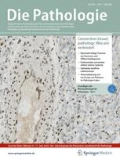Zusammenfassung
Eine wichtige Differentialdiagnose der spezialisierten intestinalen Zylinderepithelmetaplasie (Barrett-Schleimhaut) ist die intestinale Metaplasie der Kardiaschleimhaut (möglicherweise Folge einer Helicobacter-Infektion). Darüber hinaus besteht die Gefahr, dass eine Barrett-Regeneratschleimhaut als niedriggradige Dysplasie (zweifelsfreie intraepitheliale Neoplasie) überdiagnostiziert wird. Dies erklärt auch das Verschwinden vieler niedriggradiger Dysplasien im weiteren Follow-up. Auf die Mukosa beschränkte Karzinome werden des öfteren lediglich als Dysplasien jedweden Schweregrades unterdiagnostiziert. Deshalb gibt es zahlreiche Versuche, die Differentialdiagnostik durch molekular-biologische Methoden zu ergänzen und zu verbesseren. Die Immunhistochemie bzw. PCR mit p53 und HER 2-neu scheinen hier Hilfestellungen zu bieten, allerdings bedeutet in beiden Fällen ein fehlender Nachweis nicht, dass im vorliegenden Fall keine Neoplasie bestehen muss. Es bleibt neben einer sorgfältig durchgeführten Endoskopie und Biopsieentnahme mit entsprechenden Angaben auf dem Untersuchungsantrag vor allem die Routine-HE-Färbung, auf die sich die histologische Diagnose stützen muss.
Abstract
The most important differential diagnosis of specialized intestinal columnar cell metaplasia (Barrett's-mucosa) is the intestinal metaplasia of the cardia mucosa (possibly caused by Helicobacter infection). Furthermore it happens from time to time that Barrett's regenerative epithelium is overdiagnosed as low-grade dysplasia (unequivocal intraepithelial neoplasia). This might explain the disappearance of many low-grade dysplasias during further follow-up. Mucosal adenocarcinomas are often underdiagnosed as dysplastic lesions. Therefore many authors tried to establish molecular methods for improvement of the diagnostic possiblities. Immunohistochemistry or PCR with p53 and HER 2-neu might give at least some help but a negative reaction does not exclude a neoplasia in every case. The gold standard is careful endoscopy and biopsy taking with good documentation of the endoscopical findings and most important still the routine H&E stain are the only reliable diagnostic tools.
Author information
Authors and Affiliations
Rights and permissions
About this article
Cite this article
Vieth, M., Seitz, G. 50 Jahre Barret-Ösophagus Aktuelle diagnostische Möglichkeiten in der Pathologie. Pathologe 22, 62–71 (2001). https://doi.org/10.1007/s002920000436
Issue Date:
DOI: https://doi.org/10.1007/s002920000436

